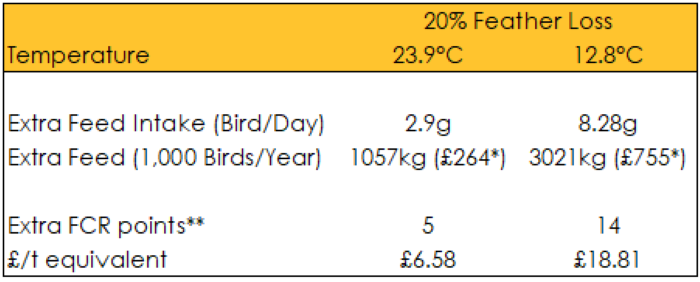
Is feather loss pecking away at your bottom line?
By Ralph Bishop, Poultry Nutritionist
- Home
- Is feather loss pecking away at your bottom line?

By Ralph Bishop, Poultry Nutritionist
Feather cover of laying hens has become a key welfare indicator, but it’s been known for some years the impact feather cover can have on layer efficiency and therefore profitability and sustainability.
Work published back in 1993 highlighted the importance of feather cover on layer performance and economics (Peguri & Coon, 1993). This should be no surprise as biologically feathers have evolved to keep birds warm in cold weather, therefore birds with fewer feathers have less insulation and will consume more feed (energy) to keep warm, see graph 1. below.

Birds tend to lose feathers through two processes, mechanical damage due to contact with equipment and pecking by other hens in the flock. Mechanical damage is difficult to control particularly in colony flocks and pecking can be more common in free range where the environment is harder to control.
Colony birds are less likely to suffer colder temperatures as their environment is easier to control, however free-range birds, rapidly becoming the norm in UK production, are exposed to extremes of temperature as pop holes are opened and birds’ range.
Extrapolation of the published data, assuming linear responses between diet energy levels, feather cover and temperature, makes for interesting reading and is worth further consideration. When feeding an 11.6MJ diet at a thermoneutral temperature of 23.9°C, a loss of 20% feather cover will lead birds to eat 2.9g per bird per day extra and feed conversion would increase if egg mass output was unchanged. Over a year this would equate to an extra 1,057kg of feed per 1000 birds or £264 per year*. At lower ambient temperatures the increase in energy required and hence feed intake is even more pronounced as illustrated in table 1. below.

Typical temperatures experienced by free range birds in the UK are below 23.9oC therefore our national free-range flock is likely to be even more affected. At 12.8°c 20% feather loss will increase feed intake by 8.28g per bird per day, 3,021kg per 1000 birds per year or £755 per year*.
Based on this calculation an investment in feed of £18.81 per tonne would be economically cost neutral, if it stopped this 20% feather loss and increase in feed intake. With further benefits to bird health, welfare and environmental impact that are harder to quantify.
Feather pecking is controlled in free range flocks through combinations of management factors, genetics and nutrition. In feed formulation the addition of extra dietary fibre stabilises the gut environment, improving litter quality and gut health as well as reducing levels of feather pecking. Fibre is typically supplied in the ration through raw materials including; barley, oats, sunflower, wheatfeed, oatfeed and wood fibre concentrates.
This all suggests that investing in feed to control feather loss, has widespread economic, social and environmental benefits to both the laying hen and the farmer that can help drive sustainable egg production into the future.
*Feed price assumed £250 per tonne in all calculations.
**Assumed 120g feed intake and 60g egg mass output at zero feather loss.
Peguri, A & Coon, C. (1993). Effect of Feather Coverage and Temperature on Layer Performance. Poultry Science. 72 (7), 1318-1329.